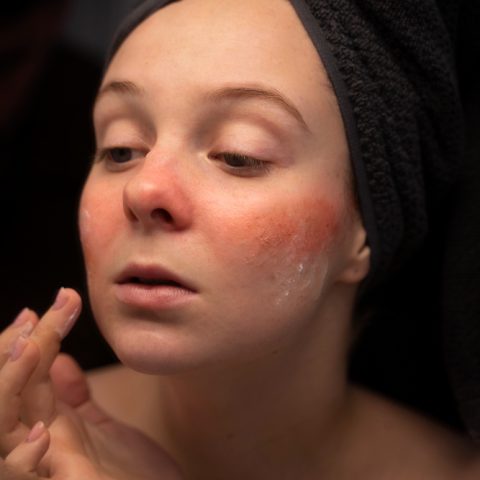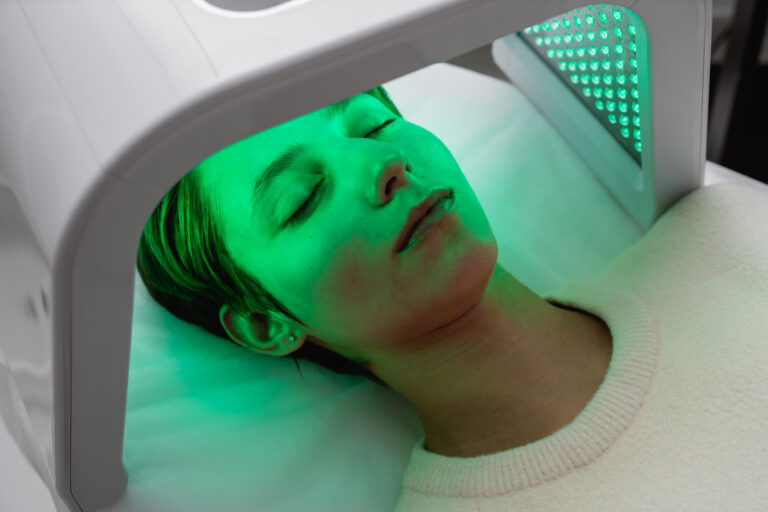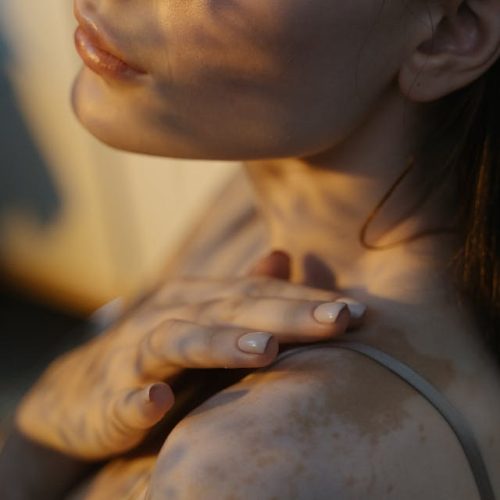Color Light Therapy: A Natural Solution for Skin Conditions and Better Skin Health
The search for alternative and complementary methods to treat skin problems has grown significantly in recent decades. Among these approaches, chromotherapy and skin treatments emerge as an intriguing option that combines ancient knowledge with modern scientific discoveries. This ancient therapeutic practice, also known as color therapy, uses the light spectrum to restore the body’s energy balance and, consequently, promote healing of various dermatological conditions.
At the end of 2008, as someone living with Vitiligo, I began to explore how chromotherapy and skin healing works, its scientific foundation, practical applications for specific conditions, and how I can incorporate these principles into a skincare routine. Unlike many conventional approaches that focus only on symptoms, color light therapy seeks to treat the skin by considering the organism as a whole, offering fascinating possibilities for those suffering from persistent skin problems.
Fundamentals of Chromotherapy and Skin Health: Understanding the Science of Colors
Chromotherapy is based on the principle that different wavelengths (colors) of light affect our organism in distinct ways. Each color of the visible spectrum possesses a specific vibrational frequency that, when applied to the skin, can promote particular biological responses. Color light therapy and skin treatments utilize this phenomenon to stimulate the body’s natural healing processes.
Recent studies in photobiology have demonstrated that skin cells have photoreceptors sensitive to specific wavelengths. When exposed to certain colors, these cells can alter their metabolic activity, resulting in effects such as increased blood circulation, stimulation of collagen production, reduction of inflammation, and acceleration of cellular regeneration. These biochemical processes form the foundation for the benefits observed when chromotherapy and skin care are appropriately combined.
A fascinating aspect of this approach is its ability to work on multiple levels simultaneously. While conventional treatment often focuses only on the physical manifestation of the problem, chromotherapy addresses both the physiological and energetic aspects of skin dysfunctions. This holistic view recognizes that many dermatological conditions have significant emotional and psychosomatic components, thus offering a more complete approach to skin health.
Dermatological Conditions Benefited by Color Light Treatment
The versatility of color light treatment and skin healing allows its application in a wide range of dermatological conditions. Let’s explore some of the most promising applications based on recent research and clinical observations.
Acne and Skin Inflammations
Blue light (wavelength of approximately 415nm) has demonstrated remarkable efficacy in treating acne. This color has antibacterial properties that directly combat Propionibacterium acnes, the bacteria associated with the development of acne lesions. Additionally, blue light can reduce sebum production and calm inflammatory processes, providing significant improvement without the side effects of many topical and oral medications.
For home treatments, chromotherapy devices with blue light are commercially available. Application for 15-20 minutes daily on affected areas can significantly reduce the quantity and severity of lesions in 4-6 weeks. This approach to chromotherapy and skin problems offers a gentle and non-invasive alternative for people who haven’t responded well to conventional treatments or who seek to complement their dermatological routine.
Psoriasis and Eczema
For chronic inflammatory conditions such as psoriasis and eczema, the combination of red light (630-700nm) and near-infrared has shown promising results. Chromotherapy and skin inflammation management utilize these light frequencies to penetrate the deeper layers of the skin, where they stimulate microcirculation and cellular regeneration, reducing the itching and scaling characteristic of these conditions.
The benefits of these colors include decreased inflammation, pain relief, accelerated healing, and modulation of the immune system. Patients report significant improvement not only in the appearance of lesions but also in overall comfort and quality of life. Regular treatments of 20-30 minutes, 3-4 times per week, can offer visible results in 8-12 weeks for moderate cases.
Vitiligo: Chromotherapy Approach for Repigmentation
Vitiligo, characterized by the loss of pigmentation in areas of the skin due to the destruction of melanocytes, represents a significant challenge for conventional dermatology. Chromotherapy and skin pigmentation restoration offers an innovative perspective for this often psychologically impactful condition. Narrow-band ultraviolet B therapy (NB-UVB) has been the gold standard photobiological treatment for vitiligo, but more recent approaches with chromotherapy and skin homeostasis are exploring combinations of specific wavelengths.
Red light (630-700nm) combined with near-infrared has demonstrated potential to stimulate proliferation and migration of residual melanocytes at the edges of depigmented lesions. Preliminary studies suggest that this combination can activate epithelial and melanocytic growth factors, promoting gradual repigmentation in selected cases.
An emerging protocol involves:
- Initial phase: Application of red light (660nm) for 15 minutes, 5 times per week
- Maintenance phase: Reduction to 3 weekly sessions after initial signs of repigmentation
- Duration: 6-12 months for significant results in responsive cases
Although it does not completely replace conventional therapies such as photochemotherapy, the chromotherapy and skin rejuvenation approach can offer a valuable complement, especially for patients who present with photosensitivity or who have not obtained satisfactory results with other methods. The combination with topical melanogenesis promoters, such as Ginkgo biloba and Picrorhiza kurroa extracts, can enhance the results.
It is important to note that efficacy varies considerably between patients, with better results generally observed in recent-onset vitiligo (less than 2 years) and in facial and neck areas. Specialized dermatological consultation is essential before starting any protocol for vitiligo.
Skin Aging and Photodamage
In the field of aesthetic medicine, chromotherapy and skin rejuvenation has gained popularity as a non-invasive anti-aging treatment. Red and amber light stimulates fibroblasts to produce more collagen and elastin, fundamental proteins for skin firmness and elasticity. This process helps reduce fine wrinkles, improve skin texture, and restore natural luminosity lost over time.
Regular chromotherapy sessions can significantly reduce damage caused by sun exposure and environmental pollution. Many dermatologists now offer professional treatments that combine different wavelengths to maximize results, while lower-intensity home devices allow continuous maintenance between clinical visits.
Practical Protocols for Chromotherapy and Skin Treatment

Implementing chromotherapy in your skincare routine requires specific knowledge about which colors to use for each condition and how to apply them correctly. Here are detailed protocols based on current research and clinical practices.
Protocol for Rosacea and Redness
Rosacea is a chronic inflammatory condition that causes persistent facial redness, dilation of blood vessels, and in some cases, inflammatory papules. Chromotherapy and skin redness reduction uses green light (520-560nm) as the main treatment due to its ability to neutralize redness and calm hyperreactive blood vessels.
Recommended protocol:
- Frequency: 4-5 weekly sessions
- Duration: 15 minutes per session.
- Method: Exposure of the affected area to filtered green light
- Complements: Combine with calming cosmetics containing colloidal oats or aloe veraTreatment duration: Minimum of 8 weeks for significant results
This protocol has demonstrated measurable reduction in the intensity of redness and frequency of flushing episodes in clinical studies, making it a valuable addition to conventional rosacea treatment.
Protocol for Healing and Acne Marks
Acne scars represent a significant therapeutic challenge. Chromotherapy and skin repair can accelerate the collagen remodeling process necessary to minimize these marks. A combination of red and near-infrared light offers the best results for this purpose.
Recommended protocol:
- Frequency: 3 sessions weekly
- Duration: 20 minutes per session
- Method: Alternation between red light (10 minutes) and infrared (10 minutes)
- Complements: Gentle exfoliation before session to increase light penetration
- Treatment duration: 12-16 weeks for recent scars; up to 6 months for old scars
This protocol is particularly effective for superficial and medium atrophic scars, although deep scars may require complementary approaches like microneedling.
Protocol for Seborrheic Dermatitis
Seborrheic dermatitis affects areas rich in sebaceous glands, such as scalp, face, and chest. Chromotherapy and skin balance restoration combines blue light to control Malassezia proliferation (fungus associated with the condition) and yellow light to modulate excessive immune response.
Recommended protocol:
- Frequency: Daily during flare-ups; 3 times weekly for maintenance
- Duration: 15 minutes of blue light followed by 10 minutes of yellow light
- Method: Direct application to affected areas with LED device
- Complements: Non-comedogenic moisturizing after sessions
- Treatment duration: 3-4 weeks for initial control; continuous maintenance as needed
This protocol can significantly reduce scaling, redness, and discomfort associated with seborrheic dermatitis, with many patients reporting improvement after the first sessions.
Devices and Technologies for Chromotherapy and Skin Improvement

The field of chromotherapy and skin technology has evolved rapidly, offering options for both professional and home use. Understanding the differences between available devices is fundamental to obtaining effective results:
Professional LED Panels
Used in dermatological and aesthetic clinics, these devices offer high light intensity and wavelength precision. They typically incorporate multiple colors in a single device, allowing combined protocols. Benefits include treating larger areas simultaneously and faster results due to higher power.
Professional panels frequently include advanced features like programmable pulses, which can increase treatment effectiveness by avoiding cellular habituation. The cost of these sessions varies considerably but generally ranges between R$200-600 per session, depending on specific technology and clinic location.
Portable Devices for Home Use
The democratization of chromotherapy and skin care has enabled the development of compact devices for personal use. These range from LED facial masks to targeted pens for treating specific areas. Although less powerful than professional equipment, they offer the advantage of convenience and consistent long-term use.
When choosing a home device, verify:
- Specific wavelengths (measured in nanometers) for your condition
- Energy density (power per area)
- Safety certifications
- Independent clinical evaluations
Investments between R$300-1500 can provide reasonably quality devices for home use, making chromotherapy and skin maintenance accessible for continuous treatments.
Chromatic Filters and Lamps
A more economical option involves using colored filters with white light sources. Although less precise than specific LEDs, this approach can be effective for mild to moderate conditions when used consistently. Lamps specially designed for chromotherapy are available and can be integrated into existing fixtures.
This option is particularly useful for prolonged low-intensity environmental exposures, complementing more intensive treatments with dedicated devices.
Integrating Chromotherapy and Skin Care into Daily Routine
Video By Anna Shvets
To maximize chromotherapy benefits, it’s important to integrate it harmoniously with other aspects of skin care. This synergistic approach potentiates results and provides holistic benefits:
Skin Preparation for Treatment
The effectiveness of chromotherapy and skin healing depends significantly on proper skin preparation. Light penetrates more efficiently into clean and adequately exfoliated skin. Recommendations include:
- Gentle cleansing with non-irritant products
- Light exfoliation (only 1-2 times per week)
- Toning to rebalance pH
- Completely dry skin before light exposure
Products containing photosensitizing ingredients (like retinoids and certain acids) should be avoided immediately before sessions, as they may cause excessive light sensitivity.
Potentiating Products
Certain cosmetic ingredients can work synergistically with chromotherapy and skin treatments to amplify results. Consider incorporating:
- Niacinamide: Strengthens skin barrier and improves receptivity to light frequencies
- Hyaluronic acid: Increases hydration, allowing better light transmission through skin layers
- Antioxidants: Protect cells against oxidative damage that could compromise therapy benefits
- Peptides: Potentiate collagen synthesis induced by red light
Apply these products after chromotherapy sessions to maximize absorption and efficacy, creating an optimized cellular environment for repair and regeneration.
Continuous Chromotherapy and Skin Protection
Chromotherapy benefits can be preserved and amplified with adequate skin protection practices:
- Daily sun protection (SPF 30+) to prevent damage that counteracts therapeutic effects
- Consistent hydration to maintain ideal barrier function
- Diet rich in antioxidants and omega-3 for internal support
- Avoid exposure to environmental pollutants and irritants
This integrated approach creates a virtuous cycle: chromotherapy and skin resilience building strengthens the skin, which in turn responds better to subsequent treatments.
Scientific Considerations and Limitations of Chromotherapy and Skin Science
While chromotherapy benefits are increasingly recognized, it’s important to approach this modality with balanced and scientific perspective:
Current Scientific Foundation
Research on chromotherapy and skin healing is expanding, with recent studies demonstrating clearer mechanisms of action. Phototherapy with visible light (particular segment of chromotherapy) has demonstrated efficacy in controlled studies for conditions like acne, psoriasis, and skin rejuvenation. Proposed mechanisms include:
- Modulation of mitochondrial activity and ATP production
- Alteration in gene expression of skin cells
- Stimulation of nitric oxide production, improving microcirculation
- Direct antimicrobial effects of specific wavelengths
However, standardization of protocols and treatment parameters remains a challenge for the scientific community, making direct comparisons between studies difficult.
Limitations and Precautions
It’s fundamental to recognize the limitations of chromotherapy and skin treatments:
- Individual response variability: Factors like skin tone, skin thickness, and underlying conditions influence results
- Condition-dependent efficacy: Certain pathologies respond better than others
- Need for consistency: Significant results generally require long-term adherence
- Contraindications: Include photodermatoses, use of photosensitizing medications, and history of skin cancer
Chromotherapy and skin treatment should not replace conventional medical approaches for serious or progressive conditions, functioning ideally as an integrated complement to the global therapeutic plan.
The Future of Chromotherapy and Skin Innovation
The horizon of chromotherapy for dermatological conditions shows promise, with several emerging trends that merit attention:
Personalized Treatments and Precision Medicine
The next evolution of chromotherapy and skin science points to highly individualized protocols based on skin biomarkers. Technologies like spectral skin analysis and 3D mapping are allowing precise identification of which wavelengths will be most effective for each person and specific condition.
Adaptive devices that automatically adjust light parameters during treatment represent another important frontier, maximizing benefits while minimizing potential adverse effects.
Integration with Other Modalities
The combination of chromotherapy and skin treatments with complementary technologies is generating notable synergistic results. Hybrid approaches include:
- Chromotherapy + microfocused ultrasound
- Pulsed light + specific light frequencies
- LED-assisted microneedling
- Targeted photosensitizing topical therapies
These combinations potentiate the individual effects of each modality, creating therapeutic possibilities that surpass the limitations of isolated treatments.
Wearables and Continuous Monitoring
Wearable devices equipped with chromotherapy and skin monitoring technology are emerging as valuable tools for treatment and prevention. Smart fabrics incorporating LEDs, bracelets with skin biomarker sensors, and programmable facial masks connected to smartphone apps represent the convergence between everyday technology and dermatological treatment.
These devices not only apply therapy but also monitor physiological responses in real-time, allowing dynamic adjustments that optimize results and document progress objectively.
Frequently Asked Questions about Chromotherapy and Skin Health
Q: Can chromotherapy replace prescribed dermatological medications?
A: Chromotherapy and skin treatments should be considered complementary, not substitutive, to conventional medical treatments. Always consult your dermatologist before modifying prescribed therapeutic regimens. In some cases, chromotherapy may allow medication reduction, but this should be done under medical supervision.
Q: How often should I perform chromotherapy sessions to see results?
A: Ideal frequency varies according to the condition treated. Generally, acute conditions like inflammatory acne can benefit from daily treatments, while chronic conditions like skin aging respond well to 3-4 weekly sessions. Visible results typically begin to appear after 4-6 weeks of consistent treatment.
Q: Is chromotherapy effective for vitiligo in all stages of the disease?
A: Chromotherapy and skin pigmentation treatment shows variable results for vitiligo, with greater efficacy in recent cases (less than 2 years) and in areas like face and neck. Vitiligo stable for many years or universal (affecting more than 80% of body surface) generally presents limited response. Combination with other treatments, like topical immunomodulators, can significantly increase repigmentation chances.
Q: Does chromotherapy work for all skin types and tones?
A: Chromotherapy and skin diversity consideration is important. Although therapy is generally safe for all phototypes, light penetration and cellular response may vary. Darker skin tones may require slightly increased intensity or duration due to higher melanin concentration, which absorbs part of the light energy.
Q: Is there risk of skin damage with prolonged chromotherapy use?
A: When used according to established guidelines, chromotherapy and skin safety is excellent. Therapeutic LEDs do not emit harmful UV radiation. However, questionable quality devices or excessively intense use may potentially cause photosensitivity or irritation. Always follow manufacturer instructions and start with conservative durations.
Q: How do I integrate chromotherapy with my current skincare routine?
A: Chromotherapy and skin care integration is simple: perform the session after cleansing and toning, but before serums and creams. Products containing niacinamide, peptides, and antioxidants are particularly synergistic when applied after sessions, while retinoids and strong acids should be reserved for distinct times of day.



